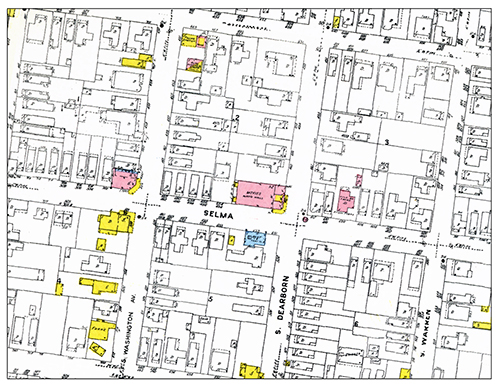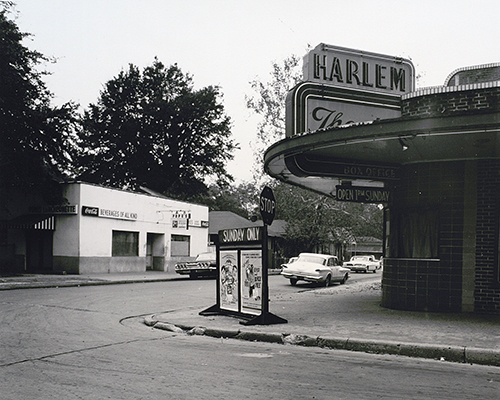Mapping Memory: Harlem Theater
Posted on February 7, 2024 by Candice Fairchild
A light beams onto your face, fragmenting the flickering glow of the theater screen. You squint in dismay, swallowing down the last bite of your snack past a lump in your throat. Caught. A floorwalker bends over your shoulder, a disapproving look on his face that you can barely make out past the glare of his flashlight. Moments like this bring Down the Bay’s Harlem Theater to life in the spoken memories of Leon Howard, interviewed by Dr. Kern Jackson:
Spoken memories of Leon Howard
Kern Jackson: “Speaking of the Harlem Theater, did the floorwalker ever catch you
eating something”.
Leon Howard: “Oh yeah, the floorwalker caught us doing everything. I can't think of
the name of this famous floor walker; he used to wear a sun visor, and he had this
big flashlight. Next thing you know, he would creep up on you and he’d shine that
light right down in your face. And if you were out of order, he would march you right
out of that theater. Saw some good movies at the Harlem Theater.”
 This 1955 Sanborn Fire Insurance Map shows the location of the Harlem Theater (the
large pink building at the corner of Selma and South Dearborn Streets). Pope’s Luncheonette
is the blue building across the street. Map courtesy of the Library of Congress.
This 1955 Sanborn Fire Insurance Map shows the location of the Harlem Theater (the
large pink building at the corner of Selma and South Dearborn Streets). Pope’s Luncheonette
is the blue building across the street. Map courtesy of the Library of Congress.
The Harlem Theater, which flourished as a mainstay of the Down the Bay community during the Jim Crow era of de jure segregation, is sustained in the memories of the folks of Down the Bay. With each mention of the theater, they transport us there, taking us on a cinematic journey of our own. Housed across the street from Pope’s Luncheonette, the local hangout as Henry Hobdy describes it, the Harlem Theater became a hub for adults seeking a sandwich and a drink while children eagerly filled the theater for a little entertainment:
Henry Hobdy
"And then, next thing, you find them—across the street from the Harlem Theater was a place called Pope’s Luncheonette. Oh, you ever heard of that? It's on Elmira Street, between Washington and Dearborn Street. I don't know if it’s still there or not. But that's where they would all hang out at. They’ll come back off the ship, and they would party at Pope Luncheonette.” -Henry Hobdy, 2022, Down the Bay Oral History Project
 The Harlem Theater and Pope’s Luncheonette. Courtesy of Mobile Housing Board Collection,
The Doy Leale McCall Rare Book and Manuscript Library, University of South Alabama.
The Harlem Theater and Pope’s Luncheonette. Courtesy of Mobile Housing Board Collection,
The Doy Leale McCall Rare Book and Manuscript Library, University of South Alabama.
Alexis Herman recalls the theater and Pope’s, combing through the neighborhood map in her mind:
Alexis Herman
“Talk about Pope’s and the theater, the Harlem Theater, that’s where I went every Sunday. Pope’s Luncheonette was the other place but it was a bar so kids couldn’t go over there. But during the day you could go and get a sandwich and get a take-out, that was okay. But the movie theaters Down the Bay was called the Harlem Theater and you got a dime every Sunday and that’s where all the Down the Bay kids went in the afternoon, was to the Harlem Theater. I forgot about the movie theater. We did have that and you say, “What did we do?” we did go to the Harlem Theater, I remember that too. I’m literally visually now going through these different neighborhoods to see what I can remember. I remember Fletcher’s, I remember the Harlem Theater, I remember by school, church, the neighborhoods, I see it all now. I was a gathering place, yep, the movies. The scent of Pope’s Luncheonette’s finest, the sound of the floorwalkers looming footsteps, and the flashes of the week’s latest screening are etched in the minds of those who sought entertainment and community at the Harlem Theater. With every mention of the theater, it becomes a site for multiplicity, housing the melding memories of all of its visitors.”
This post is part of a series entitled “Mapping Memory,” in which I take a look at various locations from the Down the Bay community by listening to the vocalized memories of community members. I draw from the archive of oral history interviews conducted as part of the Down the Bay Oral History Project.
Candice Fairchild is a second-year Ph.D. student in English at the University of Alabama. Candice has worked as a transcriber for the Down the Bay Oral History Project and finds inspiration for her blog posts from her experience listening to and transcribing those interviews.
Check out her other posts about the project:
Feeding the Community: Narrative Sustenance and Down the Bay


